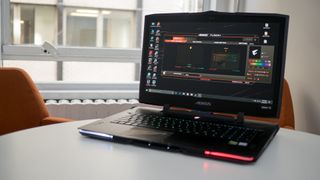TechRadar Verdict
With only one hour of battery life and dual Nvidia GTX 1070s, the Aorus X9 should really be considered a foldable desktop rather than a gaming laptop. But, holy hell, is it powerful.
Pros
- +
Unbeatable graphical performance
- +
Perfectly calibrated Pantone-certified display
- +
The best cooling system we’ve ever seen
Cons
- -
Practically non-existent battery life
- -
Lifeless keyboard
- -
Awful trackpad
Why you can trust TechRadar
The Aorus X9 is out to pack as much power as possible into an ultra-thin gaming laptop. While the Razer Blade Pro and Alienware 17 R4 have proven desktop replacements can be ultra-thin without compromise, this 17-inch gaming laptop kicks things up another notch by packing in dual graphics cards.
By harnessing the power of two Nvidia GTX 1070s, the Aorus X9 is the most graphically capable gaming laptop we’ve tested to date. What’s more, this beast of a desktop replacement also features four fans for unbeatable cooling and RGB lighting on every side. We just wish the Aorus X9 would have come with a larger battery and better inputs.

Here is the Aorus X9 configuration sent to TechRadar for review:
CPU: 2.9GHz Intel Core i7-7820HK (quad-core, 8MB cache, up to 3.9GHz)
Graphics: 2 x Nvidia GeForce GTX 1070 (8GB GDDR5 VRAM, SLI); Intel HD Graphics 630
RAM: 16GB DDR4 (2,400MHz)
Screen: 17.3-inch UHD (3,840 x 2,160) X-Rite Pantone-certified IPS display
Storage: 512GB SSD (PCIe NVMe); 1TB HDD (7,200rpm)
Ports: 1 x Thunderbolt 3 (Type-C), 1 x USB 3.1 (Type-C), 3 x USB 3.0 (Type-A), SD card reader, mini DisplayPort 1.3, HDMI 2.0, Ethernet, headphone jack, microphone jack
Connectivity: Killer Doubleshot Pro 802.11ac Wi-Fi, Bluetooth 4.1 + low-energy
Camera: HD Camera
Weight: 7.9 pounds (3.59kg)
Size: 16.9 x 12.4 x 0.9-1.18 inches (42.8 x 31.4 x 2.35-2.99 cm; W x D x H)
Price and availability
Starting at the heady price of $3,199 or £3,099, the Aorus X9 follows in the tradition of desktop replacements that cost over three grand.
At this price bracket, the 17-inch laptop is equipped with the same Intel Core i7-7820HK processor and dual Nvidia GTX 1070 graphics cards as our review unit, but only has a QHD (2,560 x 1,440), 120Hz display and a 256GB SSD. It’s also worth mentioning that you’ll only find QHD-variants of the Aorus X9 in the UK, but not in Australia.
Our review unit as configured to the right rings up for $3,649 or AU$5,099, which is slightly more affordable than the $3,799 (£3,799, AU$5,899) Razer Blade Pro. However, the Aorus X9 is also significantly more expensive than an equally well-equipped Alienware 17 R4 priced at $3,049 (£2,907, AU$4,998.
Meanwhile, if users want to double up on their flash storage, the price of the Aorus X9 bumps up to $3,799 or AU$5,399.










Design
Unlike the demure styling of Aorus’s gaming laptops that we’ve become accustomed to, the X9 is as loud as can be with edgy design elements.
The Aorus X9 fully embraces the RGB lighting revolution with a completely customizable 16.7 million-color backlit keyboard and multiple light bars around the chassis. It’s quite the lightshow, and all the more impressive when you take a closer look at the three distinct LEDs illuminating the power button and the 11 LEDs built into the light bar just above that logo.
Unfortunately, you can’t really put the lighting to good use. The most functionality we get out of the 11 LED light bar is using it as a battery meter or a temperature gauge.
While there’s also a music mode that’s neat in that it turns the laptop’s entire lighting array into a visualizer, it requires the user to increase the laptop’s volume to at least 80%. What’s worse is this music mode only works through the speakers, which basically limits its use to when you’re home and alone – that is, unless you relish in being the most obnoxious person in the room.
We would have loved it if there were a way to tie the lighting into games, like Counter Strike Global Offensive, to let us know when to reload – or when our abilities were back in Overwatch. Razer has been ahead of the game in this regard, and you’ll find all of these keyboard lighting features on all of its laptops.
Lighting aside, the Aorus X9 features a very angular design with enough metal edges to make the Lamborghini it was modeled after jealous. It looks more garish than the stealthier designs of the Aorus X5 v6 and Aorus X7 v6, but it’s balanced by the matte black paint job.
Measuring in at the same 1.18-inches (2.99cm) thickness as the Alienware 17 R4, the Aorus X9 pushes the envelope of what’s possible in an ultra-thin form-factor with its SLI-graphics card setup. Still, the Razer Blade Pro edges out as the thinnest machine measuring 0.88 inches (2.24cm).

Twack keyboard and trackpad
We were ecstatic when we first heard that the Aorus X9 would feature a mechanical keyboard with an astonishing 2.5mm of key travel. However, we are disappointed in the lack of tactile feedback from the laptop’s Kailh brown keyboard switches.
While these Kalih switches are designed to emulate the tactile bump of Cherry’s corresponding MX Brown switches on a keyboard, they feel more like they just crumbles under pressure. Pressing any of the keys even slightly causes them to bottom out without any resistance at all.
At the very least, we can say the Aorus X9 has an extremely spacious keyboard with large physical keys and more than adequate spacing between each one. Despite the lifeless feel of the keyboard, there are no problems with responsiveness. There’s no delay between us hitting the ‘G’ key and chucking out a grenade or quickly moving out of the way of oncoming rockets while gaming.
Other gaming laptops, like the MSI GT75VR Titan and Razer Blade Pro, have proven mechanical keyboards on notebooks can be as good as desktop peripherals. We really would have rather preferred if the Aorus X9 keyboard had more bite to it.
Likewise, the Elantech trackpad on the Aorus X9 is nigh unusable. Simple point-to-point tracking between our finger and the cursor is aggravatingly sluggish. What’s more, no matter how much we increase the palm rejection setting, we’re still constantly activating the sensor while typing.
Some might be able to stomach the keyboard and actually find it more usable than us, but it’s almost a requirement to replace the lackluster trackpad with a gaming mouse.
Kevin Lee was a former computing reporter at TechRadar. Kevin is now the SEO Updates Editor at IGN based in New York. He handles all of the best of tech buying guides while also dipping his hand in the entertainment and games evergreen content. Kevin has over eight years of experience in the tech and games publications with previous bylines at Polygon, PC World, and more. Outside of work, Kevin is major movie buff of cult and bad films. He also regularly plays flight & space sim and racing games. IRL he's a fan of archery, axe throwing, and board games.

